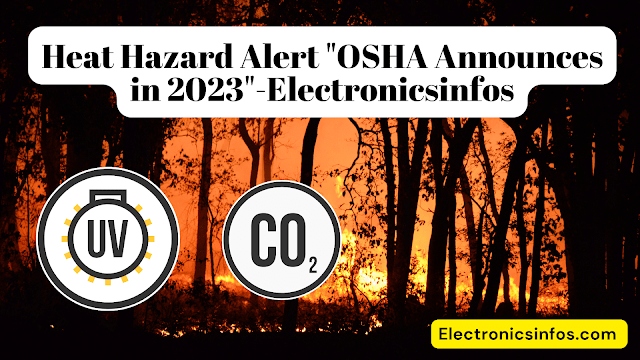Heat Hazard Alert "OSHA Announces in 2024"
On July 27, OSHA issued a heat hazard alert as a timely reminder to employers about their responsibility to safeguard workers from heat-related illnesses and injuries in both outdoor and indoor workplaces.
By taking these proactive measures, OSHA seeks to enhance workplace safety during periods of high heat and protect vulnerable workers, ensuring that appropriate measures are in place to prevent heat-related health issues.
What is a Heat Hazard Alert?
A Heat Hazard Alert is a warning issued by authorities or relevant organizations to alert the public about sweltering weather conditions that may pose health risks. A Heat Hazard Alert aims to raise awareness about the potential dangers associated with excessive heat and encourage people to take necessary precautions to protect themselves and others.
What effect of High Heat have on human life?
High heat, especially during heatwaves, can have various negative effects on individuals, communities, and the environment. Some of the bad effects of high heat include
- Heat-related Illnesses
- Dehydration
- Impact on Health Conditions
- Discomfort and Sleep Disturbance
- Power Outages
- Impact on Agriculture
- Wildfires
- Impact on Wildlife
- Infrastructure Stress
- Economic Impact
Heat-related Illnesses
Prolonged exposure to high temperatures can lead to heat-related illnesses such as heat exhaustion and heatstroke. These conditions can range from mild discomfort to life-threatening emergencies, especially for vulnerable populations like the elderly, young children, and individuals with certain medical conditions.
High heat can cause excessive sweating, leading to dehydration if an individual does not adequately replenish fluids. Severe dehydration can result in dizziness, confusion, and even loss of consciousness.
Impact on Health Conditions
Hot weather can exacerbate existing health conditions, such as cardiovascular diseases and respiratory issues. It can put additional strain on the heart and lungs, making it more challenging for individuals with these conditions to cope with the heat.
Discomfort and Sleep Disturbance
High heat can make it difficult for people to find relief and rest. Poor sleep due to discomfort and high nighttime temperatures can affect overall well-being and productivity.
Power Outages
Intense heat can put a strain on the power grid as people use air conditioning and cooling systems extensively. This increased demand can lead to power outages, causing further discomfort and potential risks, especially for those reliant on air conditioning for health reasons.
Extreme heat can damage crops and reduce agricultural productivity. It can lead to soil drying, water shortages, and stress on plants, affecting food production and prices.
Wildfires
High heat, combined with dry conditions, can increase the risk of wildfires. These fires can threaten human life, property, and the environment.
Impact on Wildlife
High heat can disrupt ecosystems and affect wildlife. It can lead to changes in animal behaviour, habitat loss, and altered migration patterns.
Infrastructure Stress
High temperatures can cause stress on infrastructure, such as roads, bridges, and buildings, leading to potential damage and safety hazards.
Economic Impact
Heatwaves can hurt industries like tourism, agriculture, and
construction. The heat can deter tourists, damage crops, and make outdoor work more challenging and dangerous.
How to Mitigate Heat Effect?
Mitigating the effects of high heat requires a combination of individual actions, community efforts, and government interventions. Here are some strategies to mitigate the negative impacts of high-heat
- Stay Hydrated
- Stay Cool
- Wear Appropriate Clothing
- Limit Outdoor Activities
- Check on Vulnerable Individuals
- Create Cooling Centers
- Heat Action Plans
- Heat-Resistant Infrastructure
- Urban Green Spaces
- Water Conservation
- Awareness and Education
- Emergency Preparedness
- Climate Change Mitigation
Stay Hydrated
Drink plenty of water throughout the day, even if you don't feel thirsty. Avoid alcohol and excessive caffeine, as they can contribute to dehydration.
Stay Cool
Seek air-conditioned spaces, such as shopping malls, libraries, or community centres, especially during the hottest parts of the day. If you don't have access to air conditioning, use fans and take cool showers to lower body temperature.
Wear Appropriate Clothing
Choose lightweight, loose-fitting, and light-coloured clothing to help your body regulate its temperature better.
Limit Outdoor Activities
Reduce physical activity and outdoor exposure during peak heat hours, typically from late morning to early evening. If you need to be outside, take frequent breaks in shaded or cooler areas.
Check on Vulnerable Individuals
Keep in touch with elderly neighbours, young children, and people with chronic health conditions to ensure they are coping well with the heat.
Create Cooling Centers
Communities can establish cooling centres during heatwaves, providing safe, air-conditioned spaces where people can seek relief from the heat.
Heat Action Plans
Local governments can implement heat action plans that include early warning systems, public advisories, and coordination with health services to respond effectively to heat-related emergencies.
Heat-Resistant Infrastructure
Design and maintain infrastructure that can withstand high temperatures and reduce heat absorption, such as cool roofs and heat-resistant pavement.
Urban Green Spaces
Promote the creation of parks and green spaces in urban areas to provide natural cooling and shade.
Water Conservation
Encourage water conservation practices to ensure adequate water supply during droughts and heat waves.
Awareness and Education
Raise public awareness about the risks of high heat and the importance of taking preventive measures through media campaigns, community workshops, and school programs.
Emergency Preparedness
Be prepared for emergencies during heatwaves. Have an emergency kit ready with essentials like water, first aid supplies, and battery-powered fans or flashlights.
Climate Change Mitigation
Address the root cause of increasing heatwaves by supporting initiatives to reduce greenhouse gas emissions and combat climate change.
By implementing these strategies and working together as individuals, communities, and governments, we can better mitigate the adverse effects of high heat and build more resilient societies that can cope with extreme weather events.


.png)



0 Comments
please do not insert spam links